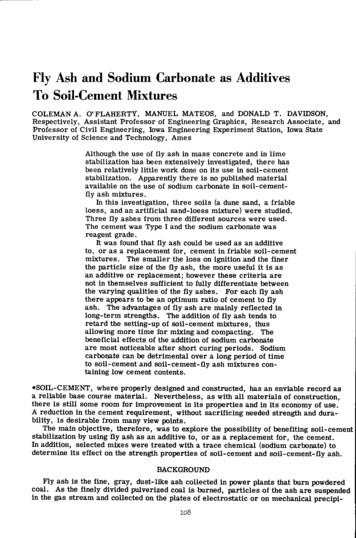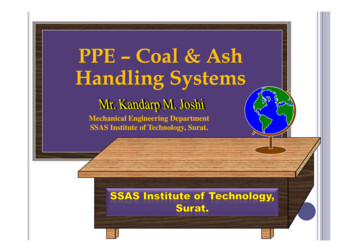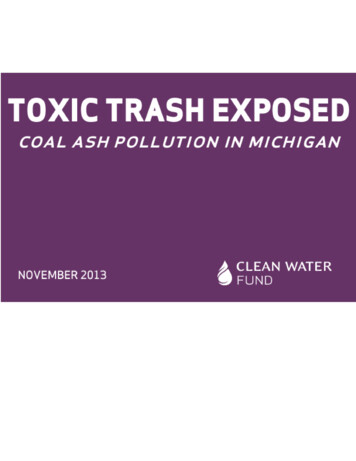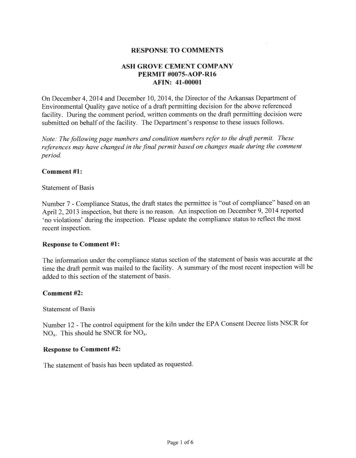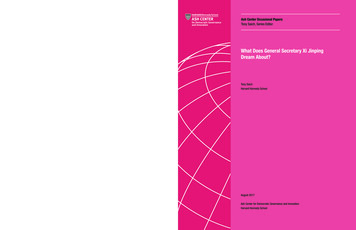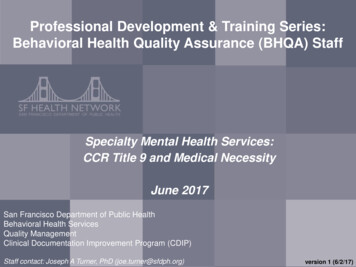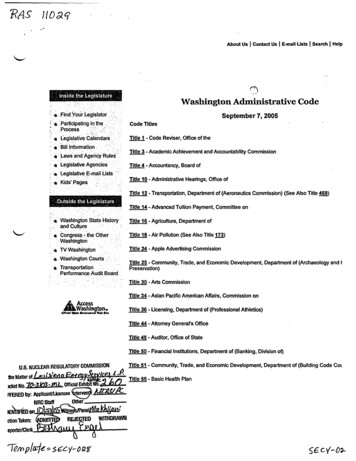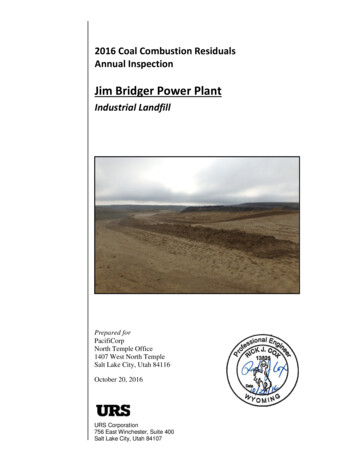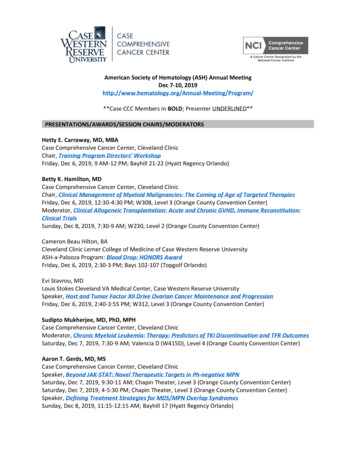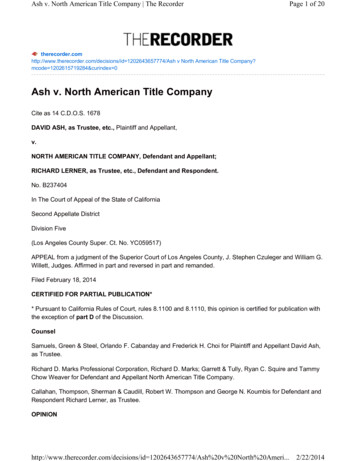
Transcription
Ash v. North American Title Company The RecorderPage 1 of ons/id 1202643657774/Ash v North American Title Company?mcode 1202615719284&curindex 0Ash v. North American Title CompanyCite as 14 C.D.O.S. 1678DAVID ASH, as Trustee, etc., Plaintiff and Appellant,v.NORTH AMERICAN TITLE COMPANY, Defendant and Appellant;RICHARD LERNER, as Trustee, etc., Defendant and Respondent.No. B237404In The Court of Appeal of the State of CaliforniaSecond Appellate DistrictDivision Five(Los Angeles County Super. Ct. No. YC059517)APPEAL from a judgment of the Superior Court of Los Angeles County, J. Stephen Czuleger and William G.Willett, Judges. Affirmed in part and reversed in part and remanded.Filed February 18, 2014CERTIFIED FOR PARTIAL PUBLICATION** Pursuant to California Rules of Court, rules 8.1100 and 8.1110, this opinion is certified for publication withthe exception of part D of the Discussion.CounselSamuels, Green & Steel, Orlando F. Cabanday and Frederick H. Choi for Plaintiff and Appellant David Ash,as Trustee.Richard D. Marks Professional Corporation, Richard D. Marks; Garrett & Tully, Ryan C. Squire and TammyChow Weaver for Defendant and Appellant North American Title Company.Callahan, Thompson, Sherman & Caudill, Robert W. Thompson and George N. Koumbis for Defendant andRespondent Richard Lerner, as s/id 1202643657774/Ash%20v%20North%20Ameri. 2/22/2014
Ash v. North American Title Company The RecorderPage 2 of 20INTRODUCTIONDefendant, a seller of real property, breached the real estate sales contract with plaintiff, the buyer, bycausing the closing of the escrow to be delayed so that it did not close on the agreed-upon Friday set forth inthe contract. The sale was part of an Internal Revenue Code (Title 26) section 1031 (section 1031)transaction to defer the buyer's capital gain tax on the buyer's sale of another property. The buyer had themoney payable on his sale of the other property deposited in a segregated account with a section 1031qualified exchange intermediary (section 1031 intermediary).FN:1 On the Monday after the sale had beenscheduled to close, the section 1031 intermediary closed and then filed for bankruptcy. The bankruptcy courtdid not release the buyer's money until after it was too late legally to qualify for deferral of taxes undersection 1031.A jury found the seller and the escrow company at fault for the escrow not closing on time—i.e., on Friday—and awarded the buyer damages against the seller for the delay, including the loss of the tax benefits. Thejury also found the escrow company liable for breach of fiduciary duty and awarded the buyer damagesagainst the escrow company for losses resulting from the delay in the closing of escrow.We reverse in part because, as discussed in the published portion of the opinion, (a) there was insufficientevidence the contract damages assessed against the seller based on the bankruptcy were foreseeable and(b), as to the escrow company, the trial court failed to instruct the jury on an intervening and supersedingcause—the bankruptcy.FACTUAL BACKGROUNDFN:2Plaintiff David Ash as trustee of the David Ash Trust (Ash), in connection with his sale of commercial realestate that realized a taxable gain, desired to defer the capital gain tax under section 1031FN:3 by purchasingcommercial property from defendant Lerner.FN:4On October 8, 2008, Ash and Lerner entered into anagreement by which Lerner agreed to sell to Ash commercial property. Defendant North American TitleCompany (NAT) was selected to be the escrow company for the purchase, for which escrow opened shortlythereafter, andwas scheduled to close on November 21, 2008—the "expected closing date."Ash was in the real estate business, and, after talking to different brokers, selected LandAmerica ExchangeServices (LandAmerica) to receive proceeds from the sale of his property in order to comply with section1031.FN:5When he entered into the agreement with LandAmerica, he had no concerns about its "financialviability." He chose LandAmerica based on "the opinion of the [p]eople [he] spoke to about it." When asked ifhe was "scared to lose [his] money if he got into a 1031 exchange," he responded "no." Ash was toldLandAmerica had various branches and was part of LandAmerica Commercial Services. Ash had usedLandAmerica for another replacement property.At some point during the escrow period after the purchase and escrow agreements were executed, Ash hadconcerns, "I was afraid of the wholeindustry everywhere . . . the banking system was, like, collapsing at thetime. So -- Ialso needed income. So I wanted to do something as quick as possible to get my income andalso to be protected." He had nevertheless chosen to use LandAmerica, signing the papers on November13, 2008, over a month after escrow opened, although the paperwork with LandAmerica was dated as ofOctober 9, 2008. He later said that near the closing date he was worried about his money because hewanted the income: "I wanted to get it done." Ash had told NAT that he needed the income from the propertyhe purchased to have the escrow completed because he wanted to have his funds safely reinvested. Ashnever said he was concerned at any time specifically about the financial condition of d 1202643657774/Ash%20v%20North%20Ameri. 2/22/2014
Ash v. North American Title Company The RecorderPage 3 of 20Under section 1031, in order to defer paying the capital gains tax on the sale of his other property, Ash wasrequired to close his transaction with Lerner within 180 days of the sale of Ash's property.FN:6 Ash had theproceeds from the sale of his property on which the escrow had closed deposited with LandAmerica, usingan account at Citibank. This was a segregated account that paid a lower interest rate than an account thatpooled money from other investors. Ash verified that the funds were in the Citibank account. Neither Lernernor NAT had any involvement with the selection of LandAmerica. As noted, the escrow was to close onFriday, November 21, 2008, but it wasanticipated by both defendants that the escrow would take a few moredays to close. When so informed, Ash responded, "no problem do I get a discount[J] (jk) [just kidding].Thank you!!" Ash's response expressed no concern about the status of LandAmerica. On Monday,November 24, 2008, LandAmerica froze all of its accounts, including segregated accounts, and then filed forbankruptcy.Ash's real estate broker was aware of LandAmerica and the number of people who used it. He believed itwas a "very substantial company" and a "very large company" and knew of its affiliated companies. He saidhe told Ash it was a reputable company. Ash's broker said he too was "shocked" and "everybody wasshocked" when LandAmerica closed its doors. Ash had expressed no concerns to Lerner or to NAT aboutthe financial solvency of LandAmerica. The escrow officer at NAT who had worked with LandAmerica hadno concerns about the solvency of LandAmerica prior to the bankruptcy. She said she was "shocked" uponhearing LandAmerica had closed.Ash's expert, who once worked for LandAmerica, said it was "unusual," "alarming," and "unique"thatLandAmerica closed its doors. She added that escrow holders would not get information about rumorsconcerning a section 1031 qualified intermediary, and if they did, they would not necessarily inform theprincipals to escrow accounts of such rumors. She could not say that any such rumors about LandAmericawere generally known by people in the real estate industry in Southern California. There is no evidence thatAsh, and more importantly defendants, were aware of any such rumors about LandAmerica. The real estateagents involved, in addition to the escrow officer for NAT, said they were "shocked" and surprised aboutLandAmerica's bankruptcy. A LandAmerica employee handling the matter said she had been involved in5000 or more section 1031 exchanges and apparently had no warning of an impending LandAmericabankruptcy. That LandAmerica employee said, "There was never any doubt until 9:00 a.m. on the morning ofNovember 24 [the date the business closed] that the money would be available." She added that the eventwas so traumatic that it was even worse than the death of her father—"worse than anything"; "absolutelybeyond description." She added, "everybody [at LandAmerica] was very angry and couldn't understand howit could happen." Another LandAmerica employee said she had no awareness of any financial problems withLandAmerica. Ash's real estate agent, who had been in the industry for more than 35 years and involvedwith section 1031 exchanges, said this was the first one in which a qualified intermediary failed to fund theescrow.FN:7 Despite Ash's hopes and the fact that the money was in a segregated account, the bankruptcycourt refused to allow depositors, including Ash, to have access to their deposited monies.Ash did not cancel the transaction because he was concerned he might lose his deposits and would beunable to complete the tax-deferred exchange. He continued to pay interest on the bank loan he had takenout to purchase the property without the income from the property to use for loan payments. The bankrequired Ash to repay the loan after five months because there was no deed of trust recorded to secure theloan. Without income from the property, he was requiredto borrow money from his mother. He also neededto hire an attorney to attempt to convince the bankruptcy court to release his moneyin order to complete s/id 1202643657774/Ash%20v%20North%20Ameri. 2/22/2014
Ash v. North American Title Company The RecorderPage 4 of 20The escrow did not close until March 2010, after the bankruptcy court finally released Ash's funds. Theclosing of escrow was too late for Ash to obtain the section 1031 tax deferral of his capital gain taxes.FN:8As a result of the delayed escrow and the delay in recovering his funds resulting from the bankruptcy, Ashsued Lerner and NAT for damages, including Ash's legal expenses of 140,000 incurred in the bankruptcyproceeding and tax liability of 465,000 due to the failure of the section 1031 exchange. Additionally, Ashclaimed 166,000 in income from the property if the sale had been timely completed, payments to the lenderof 42,000, 189,000 paid for a new loan above what he would have paid for the original loan that wasterminated by the original lender, and 28,000 of interest on a loan to meet expenses. These directdamages totaled 1,033,000.FN:9Ash also sought indirect damages of 1 million attributed to his loss of cashflow to retain and purchase properties.Defendants' made motions for nonsuit based on a lack of causation and the defense of intervening andsuperseding cause. The trial court denied the motions and refused to give defendants' proposed instructionson causation and intervening/ superseding cause.The jury returned its verdict finding that Lerner breached its contract by delaying the timely close of escrow,and was liable to Ash for 300,000, and that NAT breached its contract with Ash to provide proper andtimely escrow and title services and was liable for 250,000 in contract damages. The jury also found thatNAT was liable for negligence in the amount of 500,000 and for 250,000 for breach of fiduciary duty. Thejury imposed punitive damages on NAT in the amount of 750,000. The trial court granted NAT's motion forjudgment notwithstanding the verdict as to the punitive damage award, but otherwise denied the motions fornew trial and judgment notwithstanding the verdict. Lerner and NAT timely appealed. Ash cross-appealed inconnection with the punitive damages.DISCUSSIONA. Standard of ReviewThe determinations of whether there was a breach of contract and whether the contract damages areforeseeable are questions of fact (Plut v. Fireman's Fund Ins. Co. (2000) 85 Cal.App.4th 98, 105-106; SunMaid Raisin Growers v. Victor Packing Co. (1983) 146 Cal.App.3d 787, 790; Porter v. Arthur Murray, Inc.(1967) 249 Cal.App.2d 410, 421;) and are governed by the substantial evidence test (Garlock SealingTechnologies, LLC v. NAK Sealing Technologies Corp. (2007) 148 Cal.App.4th 937, 955-956; Lenk v. TotalWestern, Inc. (2001) 89 Cal.App.4th 959, 968)—i.e. whether there is substantial evidence to support thefindings of the trier of fact. "'Substantial evidence . . . is not synonymous with "any" evidence. Instead, it is"'substantial proof of the essentials which the law requires.'"' [Citation.]" (Roddenberry v. Roddenberry(1996) 44 Cal.App.4th 634, 651.) We view the evidence in the light most favorable to the prevailing partyand draw all reasonable inferences and resolve all conflicts in its favor. (Hub City Solid Waste Services, Inc.v. City of Compton (2010) 186 Cal.App.4th 1114, 1128-1129.) Regarding whether the failure to give aninstruction on intervening and superseding cause was error, we use the de novo standard of review. (Collinsv. Navistar, Inc. (2013) 214 Cal.App.4th 1486, 1500.)B. Damages Against Lerner and NAT for Breach of Contract—Forseeability"Contract damages are generally limited to those within the contemplation of the parties when the contractwas entered into or at least reasonably foreseeable by them at that time; consequential damages beyondthe expectations of the parties are not recoverable. [¶] In contrast, tort damages are awarded to compensatethe victim for injury suffered. [Citation.] 'For the breach of an obligation not arising from contract, thehttp://www.therecorder.com/decisions/id 1202643657774/Ash%20v%20North%20Ameri. 2/22/2014
Ash v. North American Title Company The RecorderPage 5 of 20measure of damages . . . is the amount which will compensate for all the detriment proximately causedthereby, whether it could have been anticipated or not.' (Civ. Code, § 3333.)" (Applied Equipment Corp. v.Litton Saudi Arabia Ltd. (1994) 7 Cal.4th 503, 515-516.)The court in Lewis Jorge Construction Management, Inc. v. Pomona Unified School Dist. (2004) 34 Cal.4th960, 969 (Lewis Jorge) discussed this principle, pointing out that California follows the common law rule setforth by an English court in Hadley v. Baxendale (1854) 156 Eng.Rep. 145. In that venerable English case, ashaft in Hadley's mill broke rendering the mill inoperable. Hadley contracted with Baxendale to transport theshaft to an engineer to make a duplicate. Hadley told Baxendale the shaft should be sent immediately, andBaxendale promised to have it delivered the next day. Baxendale did not know the mill would be inoperableuntil the new shaft arrived. Baxendale did not transport the shaft in the promised time, causing the mill to beshut down for an additional five days. Hadley sued, inter alia, for lost profits resulting from the delay. Thecourt held that although a plaintiff is entitled to an amount that will place it in the same position it would havebeen had the breaching party performed, damages for special circumstances, such as in that case, can beassessed against the breaching party only when they were within the contemplation of both parties as aprobable consequence of a breach. Baxendale did not know that the mill would be shut down and wouldremain shut until the new shaft arrived. Loss of profits could not fairly or reasonably have been contemplatedby both parties without Hadley having communicated the special circumstances to Baxendale. Thus, thecourt, in reversing the judgment, held that lost profits could not be awarded to Hadley. (Id. at p. 152.)The court in Lewis Jorge, supra, 34 Cal.4th at pages 969 through 970 added, "Hadley did not expresslydistinguish between general and special damages. But such a distinction flows naturally from that case;hence the rule that a party assumes the risk of special damages liability for unusual losses arising fromspecial circumstances only if it was 'advised of the facts concerning special harm which might result' frombreach—it is not deemed to have assumed such additional risk, however, simply by entering into thecontract. [Citations.] [¶] The Hadley rule has long been applied by California courts, which view it as havingbeen incorporated into California Civil Code section 3300's definition of the damages available for breach ofa contract. [Citations.] Contract damages, unlike damages in tort (Civ. Code, § 3333), do not permit recoveryfor unanticipated injury. [Citation.] Parties may voluntarily assume the risk of liability for unusual losses, butto do so they must be told, at the time the contract is made, of any special harm likely to result from a breach[citations]. Alternatively, the nature of the contract or the circumstances in which it is made may compel theinference that the defendant should have contemplated the fact that such a loss would be 'the probableresult' of the defendant's breach. [Citation.] Not recoverable as special damages are those 'beyond theexpectations of the parties.' [Citation.] Special damages for breach of contract are limited to losses that wereeither actually foreseen [citation] or were 'reasonably foreseeable' when the contract was formed.[Citation.]" (See Erlich v. Menezes (1999) 21 Cal.4th 543, 550; Greenwich S.F., LLC v. Wong (2010) 190Cal.App.4th 739, 760 [special damages not foreseeable as a matter of law]; see also California Press Mfg.Co. v. Stafford Packing Co. (1923) 192 Cal. 479, 483.) In III Farnsworth on Contracts (3d ed. 2004) section12.14, pages 260 to 262 (Farnsworth), the author sets forth the criteria for foreseeability in part as follows:"foreseeability is to be determined as of the time of the making of the contract"; "what must be foreseeable isonly that the loss would result if the breach occurred"; "it is foreseeability only by the party in breach that isdeterminative"; "foreseeability has an objective character"; and "the loss need only have been foreseeableas a probable, as opposed to a necessary or certain, result of the breach."The instant case is governed by the Hadley v. Baxendale, supra, 156 Eng.Rep. 145 principle adopted by ourSupreme Court. To the extent any part of the 250,000 of damages for the breaches of contract by Lernerand NAT is attributable to expenses incurred in connection with the bankruptcy and the loss of the deferralof the capital gains tax, such damages are not general damages, i.e., those "'which, in the ordinary course ofhttp://www.therecorder.com/decisions/id 1202643657774/Ash%20v%20North%20Ameri. 2/22/2014
Ash v. North American Title Company The RecorderPage 6 of 20things, would be likely to result'" from the breach (Civ. Code, § 3300) and which "flow directly andnecessarily from a breach of contract, or that are a natural result of a breach" and are within thecontemplation of the parties. (Lewis Jorge, supra, 34 Cal.4th at p. 968.) Rather, they "are secondary orderivative losses arising from circumstances that are particular to the contract or to the parties." (Ibid.) These"[s]pecial damages are recoverable if the special or particular circumstances from which they arise wereactually communicated to or known by the breaching party (a subjective test) or were matters of which thebreaching party should have been aware at the time of contracting (an objective test)." (Id. at pp. 968-969.)Moreover, "[s]pecial damages 'will not be presumed from the mere breach' but represent loss that 'occurredby reason of injuries following from' the breach. [Citation.]" (Id. at p. 969.)Because counsels' arguments to the jury are not evidence, we look to the testimony of the witnesses andthe documents introduced as exhibits to assess the foreseeability of the bankruptcy. There is no evidence inthe record that Ash communicated to Lerner or NAT at the time of contracting—the relevant time—or atanytime, that the bankruptcy of LandAmerica and indefinite freezing of segregated accounts could resultfrom a short but untimely delay in the escrow closing. There is no evidence in the record, expert orotherwise, that Lerner or NAT knew or should have known of this risk at the time of contracting or anytime.The transaction in issue took place in the fall of 2008, during an economic recession. Evidence of thevarious events that allegedly took place during 2008 and their timing is not in the record. There is noevidence as to what facts Lerner or NAT knew concerning those events. Whatever Ash's apprehensionswere are irrelevant. Only the communications to or knowledge of Lerner and NAT are relevant toforeseeability.Ash, even though ostensibly risk averse, having been in the real estate business and having consultedothers in the business, chose the 1031 exchange intermediary and purportedly protected himself by havingthe proceeds of his sale deposited in a segregated account. There is not substantial, if any, evidence thatunder these circumstances, Ash was aware of any risk to the funds he placed in a segregated account,much less that he communicated any such risk to Lerner or NAT or that Lerner or NAT should have knownof any such risk. That Ash was not aware of any risk supports the position that neither Lerner nor NAT wasaware or should have been aware of any such risk at the time of the contract.The real estate brokers and agents involved, an escrow expert, and a LandAmerica employee, all testifiedthat they did not foresee any risk to the funds deposited with LandAmerica. Ash's damages expert statedthat what occurred is "a fairly rare occurrence" and is "fairly unusual." Again, this evidence dispels anynotion that Lerner or NAT were or should have foreseen the risk of bankruptcy.Lerner just wanted to sell hisproperty, and NAT was just the escrow company. Presumably, it did not matter to Lerner or NAT whetherthe sale was part of a section 1031 exchange, other than the exchange was what motivated the buyer, Ash.To suggest that Lerner and NAT should have known of the risk is speculation and not based on anyevidence. There is no evidence that the parties to the transaction were concerned that the economy or otherinstitutional failures created a risk to the funds placed in a segregated account with LandAmerica. Theevidence does not show that LandAmerica was part of purported banking system problems of which Ashwas aware. He had used LandAmerica for escrow and other services before. There is nothing in the recordor even argued by Ash concerning the precise nature of economic conditions at the time of the contract andhow they might have impacted a section 1031 qualified intermediary such as LandAmerica, which is not abank. There was no evidence that Lerner and NAT knew or should have known at the time of contractingthat if the escrow did not close in time, the section 1031 qualified intermediary selected by Ash would orcould go bankrupt or that Ash would or might not be able to recover his funds in time to qualify for a taxdeferral. The papers appointing LandAmerica to serve as a section 1031 intermediary were signed over ahttp://www.therecorder.com/decisions/id 1202643657774/Ash%20v%20North%20Ameri. 2/22/2014
Ash v. North American Title Company The RecorderPage 7 of 20month after the escrow opened. Thus, defendants did not contemplate the LandAmerica bankruptcy or theconsequences thereof.That there is no evidence in the record that at the time of the contracts the bankruptcy of LandAmerica wasreasonably foreseeable by any of the participants—most importantly, Lerner and NAT—is consistent withthe general view that bankruptcies normally are not within the contemplation of the parties at the time of acontract. (See Fiduciary Trust Co. v. Bingham Dana & Gould & Others (2003) 789 N.E.2d 171, 178["plaintiffs offered nothing to refute or even to suggest Gaston's bankruptcy was reasonably foreseeable . . .at the time" of defendant's alleged malpractice]; Martin Marietta Corp. v. Fireman's Fund Ins. Co. (4th Cir.1988) 852 F.2d 566, 570 ["financial ruin of an apparently sound company is not normally a foreseeableconsequence of those acts"]; Held Construction Co. v. Michigan National Bank of Detroit (Mich.App. 1983)335 N.W.2d 8, 10; In re Construction Diversification, Inc. (D.C. Mich. 1983) 36 B.R. 434, 439 [bankruptcydamages not recoverable in breach of contract action absent bad faith]; Howard v. Nicholson (Mo.App.1977) 556 S.W.2d 477, 483 ["While the possibility of bankruptcy of businesses in general is a foreseeableand all-too-frequent occurrence, the future bankruptcy of a particular company, the continuing existence ofwhich was essential to complete the entire transaction, was not reasonably within the contemplation of theparties at the time of contracting such that the parties would have made provision for such an event"].)FN:10As stated in one authoritative work, "[u]nless financial ruin is a consequence arising naturally from abreach of contract, damages sought by the nonbreaching party for financial ruin are not recoverable unlessa risk of insolvency was within the actual contemplation of the parties at the time the contract wasmade." (Henshaw and Kempflen, 7 Mich. Civ. Jur. Damages (2013) § 77.)There are certain situations, unlike the one here, in which a bankruptcy is foreseeable if there is a breach ofcontract. For example, when a health maintenance organization improperly terminates a contract with ahealthcare provider, it can expect dire financial consequences will arise for the latter. (See In re DoctorsHealth, Inc. v. Nylcare Health Plans of the Mid-Atlantic, Inc. (D.Md. 2005) 335 B.R. 95, 121.) If the breachingparty breaches a contract to purchase stock when he knows of the other party's desperate financial need tosell the stock, a bankruptcy might be considered foreseeable. (See Hallmark v. Hand (Tex.App. 1992) 833S.W.2d 603, 612.) When an insurer wrongfully refuses to pay a claim, the adverse financial consequencescan be foreseeable. (Cf. Reichert v. General Ins. Co. of America (1968) 68 Cal.2d 822 [issue not reached].)Here, there was no evidence the parties considered the bankruptcy of LandAmerica to be a foreseeableconsequence of any delay. As noted, Ash deposited the sums in a segregated account with theunderstanding they would be safe. If he thought they were safe, there was no reason to conclude thatdefendants nevertheless should have contemplated that the deposit was unsafe.Also, there was no evidence that Lerner or NAT had any knowledge at the time of contracting of thepossibility that a bankruptcy judge for such a lengthy period of time would not release the money in asegregated account. Indeed, under the circumstances, it was unforeseeablethat a bankruptcy court wouldnot release the funds in an account, especially in a segregated account, in time to meet the requirements fora tax free exchange. (See Funk, supra, 25 No. 2 Prac. Tax Law 43; Roth et al., Committee EducationalSession: Bankruptcy Taxation/Real Estate Lessons from LandAmerica: Who Has My Money? TheUnexpected Perils of § 541, Dec. 1, 2011 American Bankruptcy Institute 449 ["Outrage and Acrimony overthe Court's decision [in the LandAmerica case]"]; Siegel v. Boston (In re Sale Guar. Corp.) (9th Cir. 1998)220 B.R. 660, aff'd (9th Cir. 2000) 199 F.3d 1375 [funds deposited in a separate trust account of qualifiedintermediary are not property of the bankruptcy estate].) Moreover, there was no evidence that defendantsat the time of the contracts had knowledge that Ash would incur expenses related to the bankruptcy.http://www.therecorder.com/decisions/id 1202643657774/Ash%20v%20North%20Ameri. 2/22/2014
Ash v. North American Title Company The RecorderPage 8 of 20As stated in Williston on Contracts, "If the contract is silent with respect to the risks the defendant hasassumed, the court will determine what risks were foreseen or foreseeable when the contract was made byviewing the matter in the light of common sense; and the courts will consider the nature and purpose of thecontract, and the surrounding circumstances known by the parties to exist at that time, as well as what thebreaching party may reasonably be supposed to have assumed consciously." (24 Williston on Contracts (4thed. 2013) § 64.13.) Because there was no evidence that the bankruptcy and bankruptcy judges's refusal torelease funds in a segregated account were, at the time of the contracts, within the contemplation of theLerner and NAT or that at those times they should have contemplated the probability of the result, thedamages arising from those events were not foreseeable for purposes of awarding contract damages.Accordingly, the trial court should reduce the contract damages judgment against Lerner and NAT byamounts attributable to the bankruptcy and bankruptcy court's delay in releasing the deposited funds. Thematter is remanded for determination of damages not attributable to the bankruptcy, including the legal feesin that proceeding and the bankruptcy court's delay in releasing the funds.C. Intervening and Superseding CauseThe defendants invoked the tort defense of intervening and superseding cause, but the trial court refused toinstruct the jury on those defenses. A principle in tort law is that when "subsequent to the defendant'snegligent act, an independent intervening force actively operates to produce the injury, the chain ofcausation may be broken. It is usually said that if the risk of injury might have been reasonably foreseen, thedefendant is liable, but that if the independent intervening act is highly unusual or extraordinary, notreasonably likely to happen and hence not foreseeable, it is a superseding cause, and the defendant is notliable." (6 Witkin, Summary of Cal. Law (10th ed 2005) Torts § 1197, p. 574 and case cited therein.)The Restatement Second of Torts distinguishes between "superseding cause" and "intervening force." TheRestatement Second of Torts, section 440, provides that "a superseding cause is an act of a third person orother force w
Chow Weaver for Defendant and Appellant North American Title Company. Callahan, Thompson, Sherman & Caudill, Robert W. Thompson and George N. Koumbis for Defendant and Respondent Richard Lerner, as Trustee. OPINION Ash v. North American Title Company The Recorder Page 1 of 20
